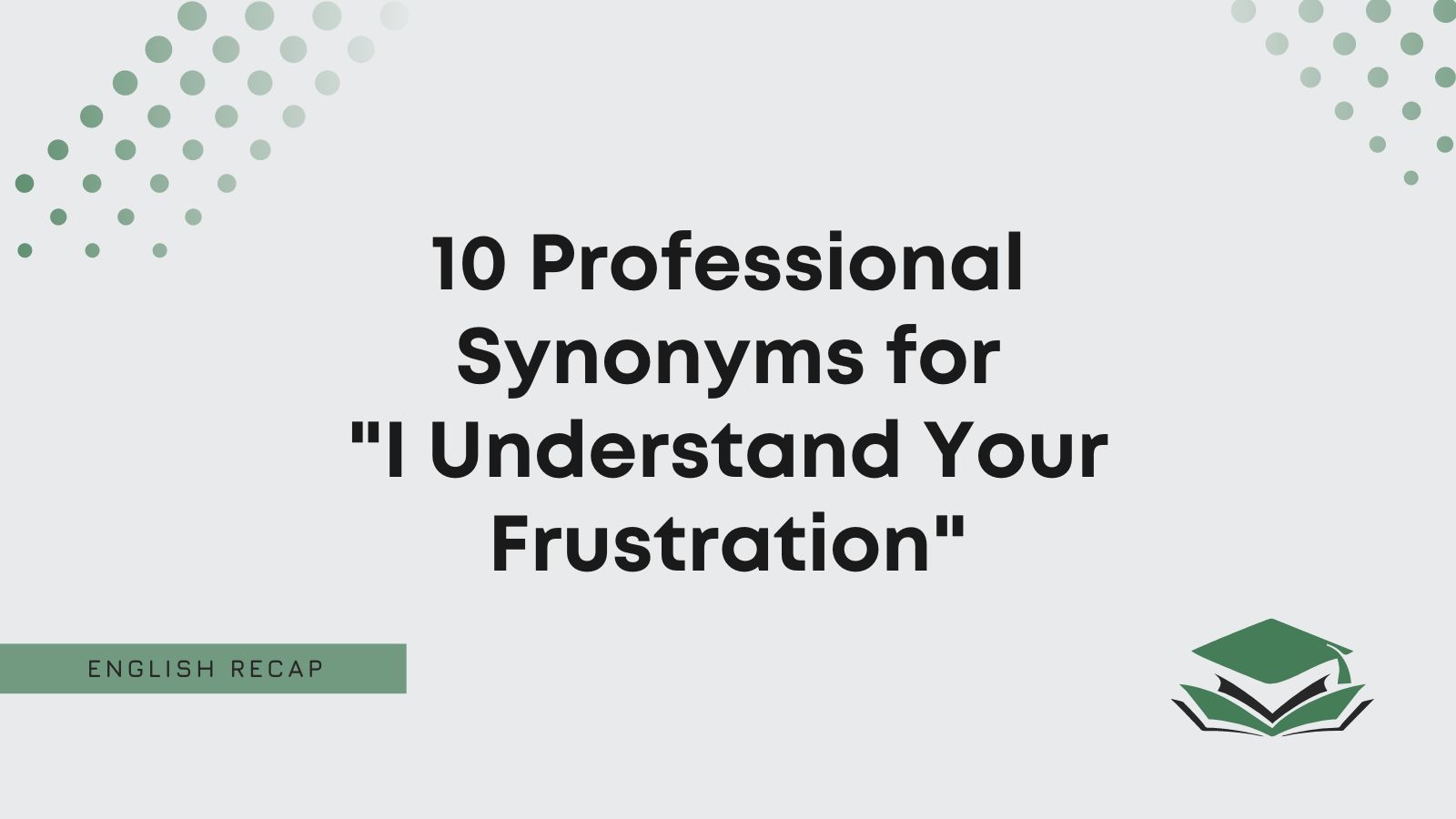So, you want to sound empathetic when someone is frustrated with you in an email.
Sometimes, you need to calm customers down, but is “I understand your frustration” really the best phrase to use?
If you’re worried it sounds generic or insincere, you’ve come to the right place.
We’ve gathered some alternatives to show you other ways to say “I understand your frustration.”
Is It Professional to Say “I Understand Your Frustration”?
It is professional to say “I understand your frustration.” Generally, it’s an effective way to express empathy with the recipient.
It works best in customer service messages or emails. It’s a great way to let customers know that you understand what they’re complaining about.
Customers will appreciate hearing that you’re on their side. So, saying something like “I understand your frustration” is a good way to say you are on their side, even if you’re not.
Feel free to review this email sample to learn more about it:
Dear Miss Right,
I understand your frustration at this time. Please bear with us while we look for a way to fix this issue.
All the best,
Hugh Roberts
Pros
- It’s useful in professional settings.
- It works well when calming customers down if they’re frustrated with your company.
Cons
- It’s fairly generic.
- It’s impersonal if you’re trying to genuinely share your empathy.
Of course, “I understand your frustration” is a great phrase to use in customer service or business emails. But that doesn’t mean you can’t explore some other options.
So, keep reading to learn how to say “I understand your frustration” professionally. We’ve covered some great alternatives to help you mix things up.
What to Say Instead of “I Understand Your Frustration”
- I can see why you’re frustrated
- I’m with you, and I understand your issue
- I acknowledge your feelings here
- I totally understand your problem
- Of course, I know what you’re going through
- I understand that this is annoying
- I recognize your frustration
- I’m aware of your annoyance
- I empathize with you
- I’m on your side with this
1. I Can See Why You’re Frustrated
If you want another way to say “I understand your frustration,” try “I can see why you’re frustrated.”
Firstly, it remains formal in an email. So, it’s a great choice that shows you empathize with the recipient.
Secondly, it is empathetic and genuine. It shows that you see where someone is coming from and understand why they’re struggling with their frustrations.
You can also review these examples if you still need help:
Dear Michael,
I can see why you’re frustrated about this change. Of course, I’ll do everything I can to help remedy the situation.
My best,
Maria Clarkson
2. I’m With You, and I Understand Your Issue
Feel free to write “I’m with you, and I understand your issue” instead of saying “I understand your frustration.”
There are two parts to this phrase, making it a genuine and polite synonym.
The first part is “I’m with you.” This shows you appreciate or agree with someone’s frustrations. Even if you don’t directly agree, it’s at least empathetic and caring.
The second part is “I understand your issue.” This is a simple alternative that shows you totally understand the problems someone has.
Here’s an example to help you see more about how it works:
Dear Mr. Adams,
I’m with you, and I understand your issue. Please bear with me while I talk to my superiors about the next steps.
Yours,
George Ryder
3. I Acknowledge Your Feelings Here
You may also find “I acknowledge your feelings here” to be a useful phrase.
It shows you appreciate someone’s thoughts and ideas and want them to know you’re on their side.
This works quite well when emailing customers who have issues. It shows you can get on board with their complaints or frustrations and want to do whatever you can to assist them.
We also recommend reviewing the following email example:
Dear Mr. Platt,
I acknowledge your feelings here. Of course, I wish it didn’t have to be this way, but I’ll see what I can do.
Yours,
Ben Rice
4. I Totally Understand Your Problem
You can use “I totally understand your problem” as another way to say “I understand your frustration.”
It’s a great way to empathize with someone’s situation. We recommend using it when emailing a client who might have come to you with help.
This should help you to create a good working relationship with your clients. Which, moving forward, will be very beneficial to your company.
Here’s a great email sample to show you how it works:
Dear Miss Kindness,
I totally understand your problem. I’ll let you know as soon as I have more information that might help you.
My best,
Joe Reacher
5. Of Course, I Know What You’re Going Through
Feel free to use “of course, I know what you’re going through.” This is a great way to show genuine care towards the recipient.
It’s empathetic and sincere. The recipient will appreciate what you’ve sent to them and might be willing to open up about their frustrations.
Try using it when contacting an employee. It shows that you understand their perspective or viewpoint and want to help them out however you can.
You should also check out the following sample email to learn more about it:
Dear Sarah,
Of course, I know what you’re going through with this problem. I’m doing the best I can, but I still need more time.
Kind regards,
Dean Grott
6. I Understand That This Is Annoying
Sometimes, we can’t stop things from being frustrating. Therefore, we can’t help it when people are annoyed about a situation.
That’s where “I understand that this is annoying comes in.”
It’s a good professional alternative to include in an email. Try using it when emailing a customer. It lets them know that you’re happy to hear from them and want to help.
Feel free to review this example as well if you still need help:
Dear Miss Jacobs,
I understand that this is annoying. However, we don’t have any other ways to get through this just yet.
Warm regards,
Georgia Dickinson
7. I Recognize Your Frustration
Try “I recognize your frustration” as a simple yet effective way to say “I understand your frustration.”
This time, we’re switching “understand” to “recognize.”
This shows that you value someone’s opinion. It’s a great way to let the recipient know you understand what they’re trying to tell you and want them to feel heard.
Use it when emailing a customer. This will let them know that you’re doing everything you can to answer their queries, especially if you think you can help.
Here’s a great example to show you more about how to use it:
Dear Mr. Touchy,
I recognize your frustration, but I’m afraid there’s nothing I can do right now. I’ll be in touch if anything changes.
Best wishes,
Sian Wright
8. I’m Aware of Your Annoyance
Feel free to include “I’m aware of your annoyance” as a slightly more formal synonym for “I understand your frustration.”
Using “I’m aware” suggests that you understand why someone is annoyed and don’t need them to explain it to you.
Instead, it validates their problems, which makes them think you’re on their side (even if you’re not).
We also recommend checking out this example to learn more:
Dear Miss Craig,
I’m aware of your annoyance. We have a few clients all sharing your sentiment, and we’re doing what we can to fix it.
Best wishes,
Daniella Kingsnorth
9. I Empathize With You
It’s worth using “I empathize with you” as a direct and friendly way to show that you see someone’s frustration.
This lets people know that you’ll do what you can to help them.
It identifies where people are struggling or what they’re frustrated with.
For instance, you can use it when replying to an employee who came to you asking for help. Generally, this will let the employee know that you’re trying your best to assist them.
Here’s a great example to help you understand it if you’re still unsure:
Dear Matilda,
I empathize with you. I know this isn’t easy, but we are working on a solution that should benefit everyone involved.
Best wishes,
Andy Lang
10. I’m on Your Side With This
Finally, you can use “I’m on your side with this.” It’s a great friendly and caring synonym for “I understand your frustration.”
You should use this when empathizing with a colleague.
Let’s say something has changed in the workplace, and your colleague is writing to you to ask for your opinion.
If you think it’s a bad change, and they agree, then you can use “I’m on your side with this.” It shows that you value the recipient’s opinion and understand they might be a bit frustrated.
You should also review this sample email:
Dear Mathew,
It’s okay; I’m on your side with this. Let’s see if there’s anything we can do to fix the problems we’re having.
Yours,
Duncan Redd

